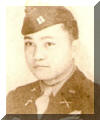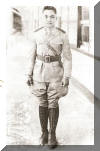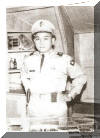 |
Arts & Culture of Zamboanga City by contributing writer & local artist: Icelle G. Borja |
|
|
IcelleARTicles: Mirrors of our Past - The Liberation of Zamboanga and our Heroes (part 2) By: Icelle Gloria Durano Borja
Sixty three years ago, today March 10, 1945, we reminisce a fateful day in Zamboanga’s history, when the City was “Liberated “ by the American Forces together with our Filipino Soldiers, Veterans and the Guerillas.
Last March 10, 2005- we witnessed the reenactment of the historical event in a tableau of Seabees, amphibious landing, jets circling the bright Zamboanga sky, amidst gunshots and artillery shelling, as the marines make the final beach landings in the Sinunuc area.
The reenactment was witnessed by many locals, Americans, and distinguished personalities who came far and wide to participate and witness the victory of the event. It was a momentous nostalgic affair when the American forces finally made touchdown to liberate the city from the bondage of the Japanese Imperial Army. To the collective mind and experience of that day, it was indeed the ‘Landing of the Eagle”
In their all–out operation to liberate the city from the Japanese, the U.S. forces under Major General Jens A. Doe, landed at the Zamboanga Beach “yellow beach"‘ in the Sinunuc area west of Zamboanga on March 10 1945, completing the operation on the 12th of the same month. The Americans named the landing area “yellow beach” as code name for the operation.
An American G.I. named Del Valle, was the lone casualty. The liberation of Zamboanga successfully carried out in seventy hours by the American forces turned out to be a mopping operation because of the wonderful collaboration between the invading forces and those of the underground movement, the native guerrillas.
Fourteen warships passed the Straits of Basilan at around five o’clock in the afternoon, and disappeared in the east. The civilians ate their supper early and prepared for the eventuality; for they believe that the American Forces would attack that night. Desperate, the Japanese burned the houses where they stored their supplies, especially those in Tetuan, and the city proper.
Early in the morning of March 10, 1945, the American warships appeared again and were within the firing range. At eight o’ clock in the morning the light cruisers and destroyers under the command of Rear Admiral F.R. Royal, began shelling the area from Baliwasan to Sinunuc, while mine sweepers cleared the approaches. Later, waves of bombers rained bombs over the landing field and other military installations. While the bombers where at it, the 41st Division went and made a beach head at Calarian on the spot called “yellow beach”
Little enemy resistance was encountered by the American Forces and the landing filed was secured in no time.
The city was then liberated, and the war-weary people met the Americans with cheers, tears and embraces. At this touching scene went on, people ransacked the storehouses left unburned by the Japanese. The American troops pursued and engaged the retreating Japanese forces in the mountains of Capisan, and fighting flared in Capisan and Cabatangan area.
Japanese baby tanks were seen fleeing for better shelter across the mountains to Capisan .
The American forces left the city May, 1946. (part 1)
There are a few extant written sources about the Liberation of Zamboanga and scarcer documents about our Men and Women who had greater contribution for playing the major role of the Liberation. Most history books on World War II were written by foreigners who maximized their own exploits and the real local heroes are relegated to the sides. I have come across some articles, written by local war Veterans from the local Daily Zamboanga Times dated 1978, wherein Jaldon is featured as a ‘brave among the bravest’. Another from the Zamboanga Directory of the 1960’s and from the Zamboanga Hermosa of Antonio Orendain dated 1984 written by Ronaldo Bautista. During my research stint at Washington D.C. at the Library of Congress I came across a substantial research material about Zamboanga during the War but It was not a published document. Mostly were the written records of war compiled by the many military units and Officers’ dossiers that were forwarded to the US Library of Congress. Access is nil not unless serious research is formally is launched. Rice and Salt written by Brigadier Gen. Magee, an American Scout was published in Texas and is a typical war memoir or autobiography during his short stint of his war experience in Zamboanga. In his book he mentioned several times the names of local soldiers and guerillas that had a hand with the resistance movement against the Japanese, his great escape and the environs of Zamboanga with the refreshing descriptions of the Pettit Barracks, Calarian Prison, Wolf Field, and the 9 hole golf course and the sad fate of the Galle Family who was massacred by runaway bandits at the scenic estate by the beach and the San Ramon Penal Farm; As prisoner of war, He wrote about the Bukidnon Prison and the Davao Prison and how he planned and executed for his great escape in the waters of Zamboanga Port.
Lest We Forget- Zamboanga in its time of peace, remembers the Humanism and Heroism of Major Celso A. Fernandez, for his numerous war exploits and even after the war he continued to exemplify the true, the just, and the few. In his Honor, a street is named after him acted and passed by the City Council Ordinance #174 March 23, 1995, renaming the existing Chico street to Major Celso A. Fernandez Street, Baliwasan near his residence, listing in his exemplary exploits aside from his medals and positions he held during World War ll and even after the War.
The positions and commands he held are as follows:
C.O. F Co. 2nd BN., 103rd Inf., 101st Div., USAFFE 1941-42 Bukidnon, Davao &Cagayan C.O. Capisan Guerilla Unit, Western Zamboanga Area 1942 C.O. 1st Separate Bn., 121st Inf., 105th Div., “A” corp., WM 19th Mil. Dist.,(Fertig’s Guerillas) 1943 Southern Zamboanga C.O. 1st Bn., 121st Inf., Reg., “A” Corps, West. Min., 10th MD (Fertig’s Guerillas) 1944-45 Southern Zamboanga Peninsula C.O. “H” weapons co., 2nd Bn., 61st Inf. Reg., PA AFWESPAC 1945-46 Zamboanga OFFICERS Schooling –U.S. Army –The Intelligence / Cavalry School, Fort Riley, Kansas, USA 1946 C.O. 72nd MPC Co., Philippine Constabulary, Zamboanga 1947-50 C.O. Phil Constabulary Commds., Zamboanga, Sulu, Cotabato Prov. Chief of Police, Integrated National Police, Basilan- 1950- 1960
His numerous commendations and citation, plaques, and certification of appreciation and other awards and medals, decorate his other memorabilia at his residence as extant reminders of his patriotic position and achievements no other Zamboangueño can surpass.
This will be the first part of the series as an attempt to piece together his biography contributed by his descendants, colleagues and other historians.
The writer, Icelle Gloria D. Borja, is a local Art Historian, Artist /Curator and Registered Nurse. Has maintained her column under “ Bellas Artes” and has contributed to the Zamboanga Website, Zamboanga.Com with her numerous articles on Art and Culture. |
||



